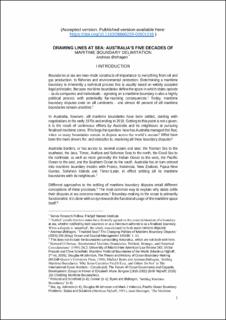| dc.contributor.author | Østhagen, Andreas | |
| dc.date.accessioned | 2023-08-08T11:40:33Z | |
| dc.date.available | 2023-08-08T11:40:33Z | |
| dc.date.created | 2022-01-12T10:53:52Z | |
| dc.date.issued | 2022 | |
| dc.identifier.citation | Australian Year Book of International Law. 2022, 39 (1), 233-260. | |
| dc.identifier.issn | 0084-7658 | |
| dc.identifier.uri | https://hdl.handle.net/11250/3083015 | |
| dc.description.abstract | Boundaries in the ocean are man-made constructs of importance to everything from oil and gas production, to fisheries and environmental protection. How do states delineate such ownership and rights? These are the core questions examined in this article, which studies Australia’s maritime boundary agreements, starting with Indonesia in 1971 and ending with Timor-Leste in 2019. In addition to depicting and documenting the main drivers and impediments to these agreements whenever Australia has had to negotiate with a third country, it examines Australia’s approach to boundary-making at sea more generally. Drawing on international law and political science, this article shows why we need understand the interplay between security politics, legal considerations and domestic interests in order to understand what motivates states to settle their maritime disputes. | |
| dc.description.abstract | Drawing Lines at Sea: Australia’s Five Decades of Maritime Boundary Delimitation | |
| dc.language.iso | eng | |
| dc.title | Drawing Lines at Sea: Australia’s Five Decades of Maritime Boundary Delimitation | |
| dc.title.alternative | Drawing Lines at Sea: Australia’s Five Decades of Maritime Boundary Delimitation | |
| dc.type | Peer reviewed | |
| dc.type | Journal article | |
| dc.description.version | acceptedVersion | |
| dc.source.pagenumber | 233-260 | |
| dc.source.volume | 39 | |
| dc.source.journal | Australian Year Book of International Law | |
| dc.source.issue | 1 | |
| dc.identifier.doi | 10.1163/26660229-03901016 | |
| dc.identifier.cristin | 1979192 | |
| dc.relation.project | Fridtjof Nansens institutt: 515 | |
| dc.relation.project | Norges forskningsråd: 315163 | |
| cristin.ispublished | true | |
| cristin.fulltext | postprint | |
| cristin.qualitycode | 1 | |
